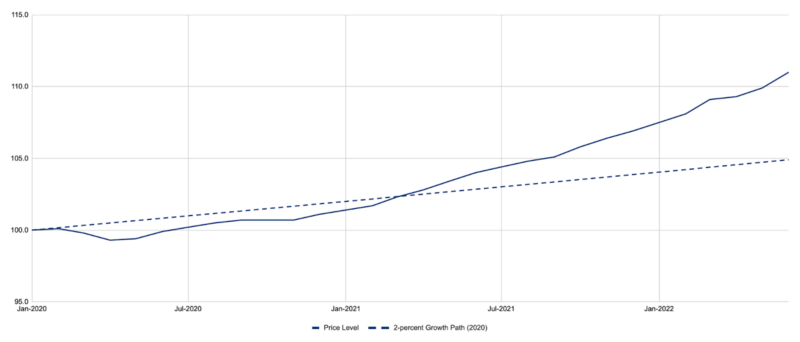
With inflation marking a 40 year high in June, everyone seems to have one question on their mind: When will inflation return to normal? July’s Consumer Price Index (CPI) print offers a glimmer of hope. Core CPI, which excludes volatile food and energy prices, grew just 0.3 percent in the month of July, down from 0.6 and 0.7 percent in the prior two months. Declining energy prices left headline CPI unchanged over the month.
Alas, the Federal Open Market Committee’s (FOMC) latest Summary of Economic Projections suggests inflation will remain high for some time. The median FOMC member is currently projecting 5.2 percent inflation in the personal consumption expenditures price index (PCEPI) for 2022; 2.6 percent inflation for 2023; 2.2 percent inflation for 2024; and 2.0 percent thereafter.
The Federal Reserve is ostensibly committed to a 2 percent average inflation target, which permits a temporarily high rate of inflation. But just because the Fed can let inflation run higher than 2 percent for a period of time doesn’t mean it should. FOMC members are asked to submit their projections under the assumption that the Fed conducts monetary policy appropriately, as they see it. Hence, their projections for inflation tell us how FOMC members think the price level should evolve.
When should inflation be higher than the Fed’s 2-percent average inflation target? In general, prices should rise above the level consistent with the Fed’s average inflation target when real output falls below its long run growth path. When supply constraints reduce our ability to produce, higher prices provide a useful signal that goods and services are relatively scarce and an incentive to scale back purchases until production recovers.
We must be careful not to confuse above-average prices with above-average inflation, however. When the economy is recovering from an adverse supply shock, for example, prices return to trend. In the process of returning to trend, prices are (1) above trend and (2) growing at a rate below the average inflation target. Hence, justifications for higher prices do not necessarily justify higher inflation. We must think carefully about where the economy is and where it is going.
Consider how prices have evolved over the last 18 months. In April 2021, prices started to rise above trend. Then, in October 2021, they began to rise more rapidly. The continuously-compounding annual inflation rate since January 2020, which had stood at 3.0 percent in August and September 2021, climbed to 3.2, 3.4, 3.5, 3.6, and 3.7 percent in the months that followed. In March 2022, it climbed to 4.0 percent, where it remained until June 2022 when it hit 4.3 percent. Hence, the question today is whether inflation should be above 2 percent given that prices are already well-above the level consistent with the Fed’s average inflation target.

What justification might Fed officials have for wanting inflation to remain above 2 percent through 2024? Perhaps they would point to lingering supply disturbances associated with the pandemic or, more recently, Russia’s invasion of Ukraine. Alas, that would not quite cut it. To the extent that these disturbances persist, they justify above-trend prices. They do not necessarily justify above-average inflation. Above-average inflation would require a general worsening of supply conditions. And, despite the modest decline in real output observed in the first two quarters of 2022, potential output has likely continued to recover. Since prices are above trend, the process of returning to trend as real output recovers would require less than 2 percent inflation—not more than 2 percent inflation, as Fed officials project.
Perhaps Fed officials think that, although the economy will largely recover from these temporary supply disturbances, these disturbances will also bring about a longer-lasting reduction in total factor productivity growth. Below-average total factor productivity growth would result in below-average real output growth and, as such, could serve as a justification for above-average inflation.
The below-average total factor productivity growth story is sensible, but strikes me as unlikely. We do not typically assume a temporary reduction in our ability to produce has a long-lasting effect on total factor productivity growth. What is different in this situation? And why would it warrant inflation to be 20 to 60 basis points above the average inflation target given that prices are already elevated well above the level consistent with the average inflation target?
I cannot think of a good reason for inflation to remain high through 2024; but many bad reasons come to mind. The most likely explanation, in my opinion, is that Fed officials do not take their average inflation target very seriously. They permitted nominal spending to surge, which pushed prices up far higher than was required given the supply disturbances realized. They will eventually get inflation back down to 2 percent—but not anytime soon. And, even then, the price level will remain permanently elevated.
* This article was originally published here
PUBLISH WITH US!
The Washington Gazette works at our discretion with businesses, non-profits, and other organizations. We do not work with socialists, crony capitalists, or disinformation groups. Click the green button below to view our services!
HELP STOP THE SPREAD OF FAKE NEWS!
SHARE our articles and like our Facebook page and follow us on Twitter!





0 Comments